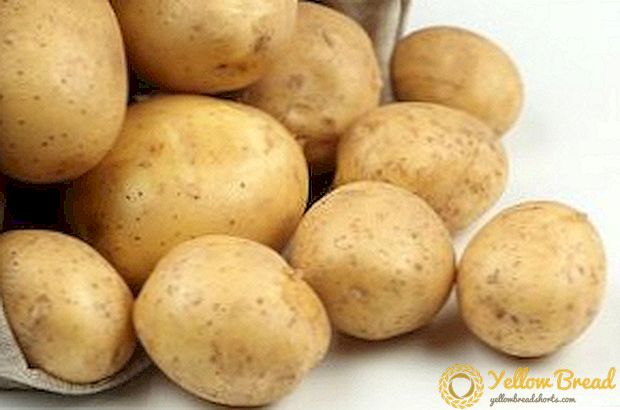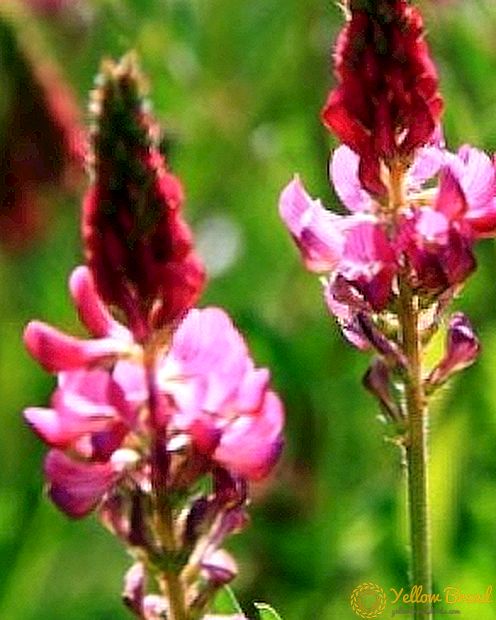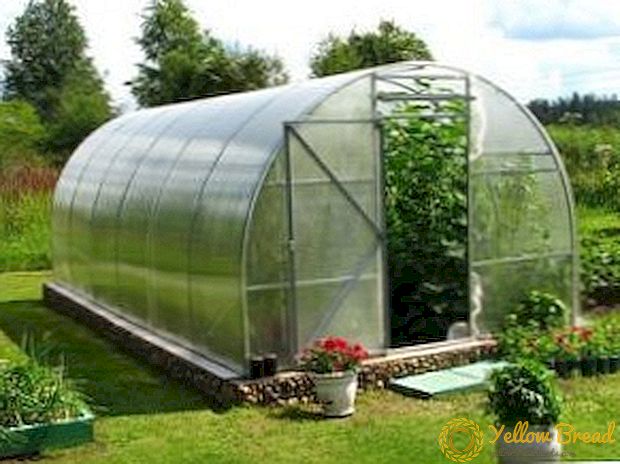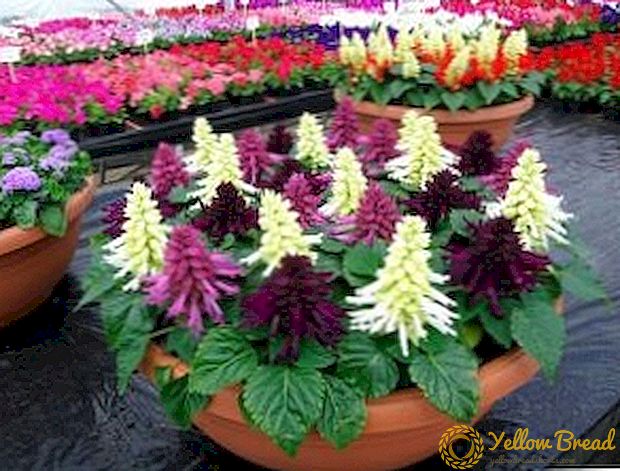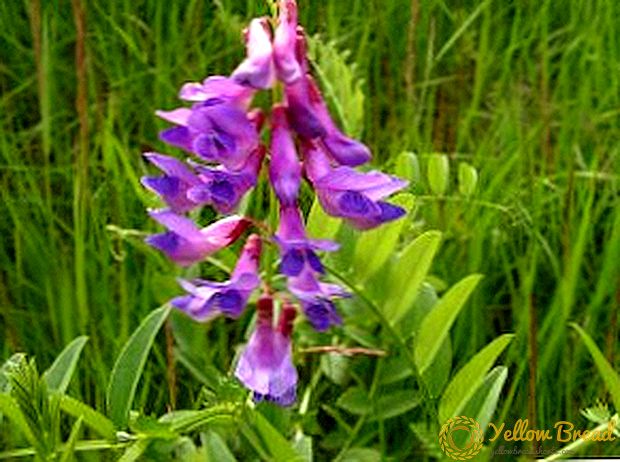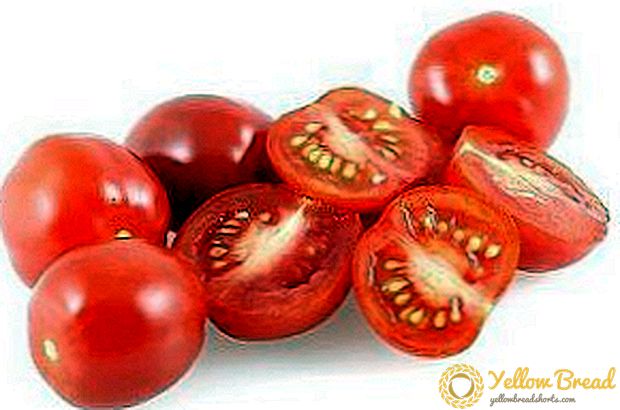 During the selection of tomatoes for future seedlings, gardeners pay great attention to taste and quality characteristics. Thanks to the hard work of the breeders today, many varieties of tomatoes have been developed that meet all the requirements of farmers. Among all this variety of varieties, cherry tomatoes are particularly notable, and despite their small size they were able to gain recognition from both experienced farmers and novice gardeners.
During the selection of tomatoes for future seedlings, gardeners pay great attention to taste and quality characteristics. Thanks to the hard work of the breeders today, many varieties of tomatoes have been developed that meet all the requirements of farmers. Among all this variety of varieties, cherry tomatoes are particularly notable, and despite their small size they were able to gain recognition from both experienced farmers and novice gardeners.
- Cherry tomatoes: a brief description and suitable varieties for the greenhouse
- Greenhouse conditions
- Air humidity and temperature
- Greenhouse lighting
- Soil requirements
- Planting a cherry tomato in a greenhouse
- The timing of planting and seed preparation
- How to sow tomatoes
- Greenhouse care
- Features care for sown seeds
- How to care for seedlings
- Rules for the care of adult tomatoes
- Are tomatoes subject to pests and diseases in the greenhouse?
- Harvesting
Cherry tomatoes: a brief description and suitable varieties for the greenhouse
Cherry tomatoes are considered small-fruited, because the weight of tomatoes is only 15-20 grams. Cherry tomatoes have one major difference from other tomatoes - an elevated (almost 2 times more) sugar content and dry nutrients. All of them are dissolved in the extracellular juice.In comparison with larger counterparts, the taste of cherry tomatoes is sweeter and more intense.
Because of its shallow root system, cherry tomatoes can be easily grown at home on the balcony or windowsill, as well as in ordinary flower pots (this fact is often indicated in the description of the variety). These tomatoes do not grow one by one, but in whole clusters, which greatly facilitates the harvest. They have a long shelf life during which they practically do not deteriorate or crack.
Cherry tomatoes have pronounced dietary properties. They strengthen the cardiovascular system, normalize metabolism, and even are used for the prevention of cancer.
In addition, a large selection work has led to the fact that some tomatoes of this variety have a very unusual taste for them. So, the sweetest cherry can give a taste of strawberries, raspberries, nutmeg and blueberries.

For growing in a greenhouse suitable for stunted and tall varieties of cherry tomatoes. Among undersized varieties can be identified:
- "Ampel" - a decorative variety that is famous for its resistance to various diseases.
- F1 "Raisin" - is a mid-season hybrid variety. Possesses small, elliptical fruits of pink color.
- F1 "Punto-7" is an ultra early greenhouse hybrid with bright red fruits;
- "Pink Cherry" - great for protected soil;
- "Cherry black." Its main feature is the small tomatoes of an amazing, dark purple hue;
- F1 "Magic cascade". This cultivar of cherry tomatoes is grown with great success both in greenhouses and in the open field;
- "Dessert". At the moment, one of the most popular varieties grown in greenhouses. Fruits have a pronounced red hue;
- F1 "Yellow Mimi" - yellow-fruited hybrid grown in greenhouses;
- F1 "Madeira" and F1 "Caprice" - mid-season greenhouse hybrids with red fruits.
Greenhouse conditions
The process of growing tomatoes in a greenhouse cherry is not very complex, the main thing - the observance of certain rules, which will be discussed below. If you equip a greenhouse with heating, then it will be possible to harvest a crop of cherry tomatoes all year round. The material from which such a greenhouse is being built is polycarbonate or glass.

Many gardeners have achieved quite a lot of success in this and turned the cultivation of cherry tomatoes in the greenhouse into a full-fledged business, bringing good profits.
Air humidity and temperature
For cherry tomatoes, the optimum air temperature in the greenhouse is + 20 ... +25 ° C during the daytime and + 16 ... +18 ° C - at night. After the fruits begin to fill, the temperature in the greenhouse should fluctuate between + 24 ... +26 ° C during the day and + 17 ... +18 ° C at night.
Cherry tomatoes, especially greenhouse varieties, need sufficiently humid air, so the humidity level should be 60-65%. In addition, the list of mandatory measures for the care of tomatoes in the greenhouse includes regular airing of the room. This procedure is especially important during flowering.
In this period of development of tomatoes on the walls of the greenhouse in any case should not form condensate.Also remember that excessive soil moisture will increase the acidity and wateriness of the tomato flesh.
Greenhouse lighting
Lighting, along with humidity and temperature, is one of the basic conditions for greenhouse tomatoes. Cherry varieties need good lighting, so when choosing a place for the construction of the greenhouse, you need to take this aspect into account.

If the lighting is weak enough, then you have to plant bushes at a great distance from each other to avoid shading. Thus, even for a small number of bushes will have to take a large area of the greenhouse.
Proper care of cherry tomatoes is unthinkable without organizing good lighting, because with a lack of light the development of tomatoes will occur slowly, their leaves will turn pale, the stems will stretch, and the buds will completely fall off.
To stimulate good growth of tomatoes in greenhouse conditions, artificial lighting is equipped,which in its characteristics should be as close as possible to the natural.
Artificial lighting for cherry tomatoes consists of four main parts:
- Stand - design, which is fixed to the lamp lighting bushes.
- Electrical ballast is a component that controls the current of low voltage.
- The lamps.
- The reflector is a plate that increases the flow of light produced by tomatoes. Also controls the level of heat emitted by the lamps.
Soil requirements
Cherry tomatoes, their planting and care for them are made only in fresh soil. Last year is not suitable for this. To reduce the likelihood of developing various diseases, as well as to increase the fertility of the soil and improve its structure, it is necessary to add peat to it. Usually, it is enough to add one bucket of peat to one square meter of soil. If necessary, peat can be replaced with sawdust or humus.

Tips soil preparation:
- If you use humus, then you need to remove all trash from it (undecomposed plant residues, etc.);
- You can use not fresh sawdust, and annual, which have already begun to decompose;
- In order to provide better aeration and increase soil looseness, you can add half a bucket of sand per square meter of soil.
Planting a cherry tomato in a greenhouse
The technology of planting small cherry tomatoes is practically no different from planting ordinary tomatoes. It can be carried out as in seedlings, and directly into open ground. Planting technology can be divided into several stages.
First you need to prepare the ground. It is preheated and treated with EM drugs (preparations containing effective microorganisms). The most popular is the means "Baikal". The appearance of the first shoots occurs 5-10 days after planting.
The timing of planting and seed preparation
The optimum time for planting a tomato in a greenhouse is the end of March or the beginning of April. If you choose seeds of hybrid varieties for cultivation in greenhouses, then you can avoid their preliminary processing. Such seeds immediately land in the ground. If you chose the usual variety of cherry, then the seeds need to prepare for the subsequent planting. For this you need:
- Carefully fold all the seeds into a small bag of fine natural fabric, then disinfect. For this, the pouch is dropped for 15 minutes into a 1% solution of potassium permanganate.
- Thoroughly rinse the seeds in clean water.
- Process nutrient solution all planting material. To prepare the solution, you need to take a liter of water and add a tablespoon of wood ash to it. The temperature of the solution should not fall below + 25 ° C. The term of stay of seeds in this solution is 12 hours, after which you can proceed to the next stage.
- For 24 hours, place a bag of seeds in a container with clean water.
- Dry the seeds, and then put them in the refrigerator, where they will stay until planting.

How to sow tomatoes
In order to get a good harvest of cherry tomatoes, their cultivation, and especially sowing, must be carried out in accordance with fairly simple rules. Sowing begins with the fact that small grooves are made on the soil surface, one and a half centimeters deep.
Seeds are preferably planted in a staggered manner, with a distance of 50-60 centimeters between plants.More rare or too frequent placement can lead to a noticeable decrease in yield. After this, the pits need to be dusted with soil and water them. In order to avoid soil erosion, you can use a spray gun.
A quick rise of seeds will be facilitated by a temperature of + 26 ... +27 ° C and lighting at least ten hours a day. During this period, it is necessary to water the soil very carefully and only if it began to dry out. This lasts 20-25 days, until a pair of true leaves appears.
Greenhouse care
For novice gardeners, the question of how to care for cherry tomatoes is quite acute. Caring for tomatoes begins with the organization of proper watering.
This variety does not tolerate drought, therefore, with a prolonged absence of moisture, the fruits will begin to crack and deteriorate. This means that the plants need to be watered daily. But at the same time it is necessary to monitor the level of moisture, because due to its oversupply, the bushes gradually begin to rot.
Cherry also needs to be tied up, because due to its own gravity, tomatoes growing on a branch can break it and fall to the ground.

Features care for sown seeds
Care of the seeds sown includes:
- Watering the soil with warm water immediately after planting seeds (such a simple procedure will contribute to better germination).
- Thinning sprouts after they reach 5-6 centimeters in height. If not all the seeds have risen, the procedure should be postponed.
- Regular loosening of the soil, for air access to the seeds.
- Periodic supplementation with complex mineral fertilizers (held once a week).
How to care for seedlings
In the question “How to grow and care for cherry tomatoes after planting?”, The main emphasis should be placed on watering and temperature control. Particular attention should be paid to this during the first three weeks after emergence. Daytime temperatures should be + 16 ... + 18 ° C, and nighttime should be + 13 ... +15 ° C. Such care should be continued until the second leaf appears on the sprout.
Watering seedlings of cherry tomatoes should be right under the root with warm water, the temperature of which should be +20 ° C. Also, plants should receive a sufficient amount of light. At the same time it is necessary to conduct regular airing of the greenhouse.
In order to grow a strong bush of cherry tomatoes, especially varieties "Fingers", it is necessary to cut off the upper part of the plant. After the shoots appear from the lower leaf axils, you will need to leave only the upper two, and remove the lower ones. Due to this, the plant will form 2 shoots, which can then be tied to the trellis.

Rules for the care of adult tomatoes
Care for ripe tomatoes is reduced to the following procedures:
- After the development of the fifth true leaf, cherry tomatoes are transferred to a new watering mode. Now the soil is moistened 3-4 times a week. The main thing - regular monitoring of the moisture balance.
- Every 10-12 days you need to feed the tomatoes, alternating mineral and organic fertilizers. Just do not overdo it, because a large concentration of nutrients in the soil can lead to rapid growth of green mass, which will prevent the formation of new fruits.
- As the soil subsides under the plant, it is necessary to gradually pour a layer of fresh substrate.
- To ensure better pollination, it is necessary to shake flowering plants 2-3 times a week.
Separately, it is necessary to say about the pinching of cherry tomatoes. In need tall bushes. For this you need to manually break off the stepchildren, leaving only the stump height of 1.5-2 centimeters. Due to this, the growth of the main shoots will be stimulated and the overall yield of the bush will increase.

After the plant has formed a large part of the ovaries, you should pinch the top of the main stem and tear off the flowering brush. Proper stewing will cause quick ripening of the fruit. Thus, the question of how strawberry cherry tomatoes can be considered closed.
Are tomatoes subject to pests and diseases in the greenhouse?
Pests and diseases cause a lot of problems in the greenhouse cultivation of tomatoes. As well as insect pests, various microorganisms - pathogens cause great harm to tomatoes. According to the class, all causative agents of diseases of cherry tomatoes can be divided into fungal, viral and bacterial.
Insect pests, along with spores of fungi and bacteria, inhabit the elements of the greenhouse, in the soil and dry plant residues.To prevent the emergence and spread of pests and diseases, the following set of measures is applied:
- Cherry tomatoes are not planted near potatoes.
- In the greenhouse, you can grow several varieties of tomatoes.
- When working with plants in a greenhouse, simple hygienic measures should be followed: regular hand washing with soap, handling equipment (shovels, hoses, shovels, etc.).
Harvesting
Tomatoes are harvested immediately after ripening. During this period, they have the best taste. Cherry tomatoes are convenient to collect whole brushes. To do this, carefully cut them, and then they come off one by one from the brush itself.

You can also pick green tomatoes, which are then placed in a cardboard box. Each layer is fenced off with a regular newspaper, after which the box is placed in a dark place where the tomatoes ripen.
Cherry tomatoes are an excellent choice for beginner gardeners as well as experienced farmers. The variety of varieties and their taste will not leave anyone indifferent.Try to grow these tomatoes on your site, and you will certainly be satisfied with the result.

